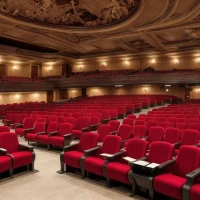Attending an event at the renowned Hippodrome Theater is nothing short of a magical experience, where every performance brings its own unique atmosphere and excitement. An integral part of ensuring the best possible experience is selecting the right seat. With this in-depth guide to the Hippodrome seating chart, you’ll have all the information and insider tips at your fingertips to select the seat that guarantees an unforgettable visit.
When you start planning your visit to this storied venue, studying the Hippodrome seating chart should be at the top of your to-do list. Whether it’s a breathtaking ballet, an uproarious comedy, or a stirring musical performance, the seat you choose can dramatically impact your enjoyment. Join us as we navigate the nuances of the Hippodrome seating chart, uncovering hidden gems and avoiding potential pitfalls.
Mastering the Hippodrome Seating Chart: An Overview
Navigating a seating chart can be a daunting task, but with the right approach, it can become a simple step toward securing your ideal theater experience. The Hippodrome seating chart is your roadmap to the visual and acoustic feasts that await. Understanding its layout is your first step towards an evening of cultural enrichment.
The Key Areas of the Hippodrome Theater
Let’s dive into the core sections of the theater as depicted in the seating chart:
- Orchestra Seating: The heartbeat of the theater’s layout, the Orchestra section is often the most sought-after area. With its proximity to the stage, this section offers an immersive experience that can make you feel part of the action.
- Mezzanine and Balcony Levels: Elevated above the orchestra, the Mezzanine and Balcony levels provide a vantage point that allows patrons to absorb the spectacle without missing a beat. The height often enhances the acoustic experience, making it a favorite for avid theater-goers.
- Box and Premium Seating: For those seeking an exclusive and intimate theater experience, box and premium seating are superb choices. These seats often come with added benefits, such as more legroom and dedicated service.
Seat Numbers and Rows: Understanding the Layout
As you peruse the Hippodrome seating chart, it’s important to get acquainted with how the seats are numbered and how the rows are laid out. Here are a couple of aspects to be mindful of:
- Seat Numbers: Usually, seat numbers follow a sequential pattern but can vary from one section to another. It is crucial to check the chart to avoid confusion.
- Row Identification: The rows in the Hippodrome can have different starting and ending points depending on the section. Detailed charts will guide you to your seat with ease.
Detailed Insights: Finding the Best Seats in Each Section
Choosing an ideal seat requires more than a quick glance at a seating chart; it requires understanding the unique advantages of each section.
Orchestra Section: The Heart of the Experience
In the Orchestra section, the middle seats typically provide the most direct view of the stage. Opting for seats within the first few rows can lead to a thrilling yet neck-straining experience.
- Front Orchestra: If you desire an up-close interaction with the performance or want to observe the intricate details of the set design, seats in the front orchestra might be for you. However, be prepared; you might miss the grandeur of large-scale productions from this angle.
- Central Orchestra: Generally considered prime seating, central orchestra seats blend proximity and a comprehensive view, offering a balanced experience.
- Rear Orchestra: These seats usually offer a full view of the stage at a more affordable price, making them an attractive option for budget-conscious theater enthusiasts.
Mezzanine and Balcony: A Different Perspective
Elevated seating can give a different perspective that many patrons prefer.
- Front Mezzanine: Typically provides stellar unobstructed views. The front rows are especially prized for their overall scene visibility.
- Back Mezzanine/Balcony: Often less expensive, these seats still offer a good view, especially in a well-designed theater.
Box and Premium Seats: The Ultimate Comfort
Box and premium seats often come with a premium price tag but for a good reason. They usually offer additional comforts, such as extra legroom and a private ambiance.
- Box Seats: These can be exceptional, providing an intimate theater experience. On the flip side, some box seats may offer a side view that’s not ideal for certain productions.
- Premium Center Seats: They are often the best in the house and provide the most centered and comprehensive view of the stage.
The Importance of Angle and Elevation in Selecting Your Seat
When selecting your seat, considering the angle and elevation in relation to the stage is crucial. How the stage appears from your seat can affect how well you can see and hear the performance.
The Angle to the Stage: Avoiding Obstructed Views
- Extreme Side Seats: Seats farthest to the sides or at an angle to the stage may lead to obscured views of the performance.
- On the Aisle: Choosing aisle seats can sometimes balance a side angle by offering a slightly clearer view past the audience in front.
Elevation Above Stage Level: Balancing View with Comfort
- Too Low: Sitting too low in the front rows can mean looking up for extended periods.
- Too High: Excessive height, especially in the upper balcony, can make the stage seem distant.
The Role of Theater Design in Your Seating Choice
The architectural design of the Hippodrome plays a significant role in the experience of each seat.
Traditional vs. Modern Theater Layouts
Traditional theaters, often U-shaped, have a charm that can come with acoustical and sightline challenges. In contrast, modern theaters tend to have more standardized sightlines and acoustics.
Visibility and Acoustics
- Sightlines: Ensure that the seat you choose has a direct line of sight to the stage without obstructions like pillars or railings.
- Acoustics: The venue’s acoustics vary depending on your location within the theater. Central seats typically offer the best sound experience.
Insider Tips: Making an Informed Seating Decision
To navigate the seating chart like a pro and secure the best seat for your needs, consider the following tips:
- Visit the Venue’s Website: Many theaters offer a virtual tour or 3D seating chart which can provide a simulation of the view from your seat.
- Read Reviews and Forums: Gleaning insights from previous attendees can alert you to quirks in the seating arrangement.
What to Avoid and What to Aim For
- Avoid: Seats with known obstructions or limited legroom unless you have no alternative or they come at a significant discount.
- Aim For: The ‘sweet spot’ seats that offer a balance of view, comfort, and price.
Final Thoughts: Securing Your Ideal Seat
In all theaters, including the Hippodrome, the selection of your seat is a delicate balance between budget, preference, and availability. The Hippodrome seating chart is your key to unlocking an experience tailored just for you.
Boldly embrace the details of each section, consider the angles and elevations, and factor in the design of the Hippodrome to guide your decision. A masterful understanding of the seating chart can lead to a perfect theater outing, complete with the thrill of the performance and the joy of a seat that feels just right.
Remember that while the best view is subjective, the shared experience of live theater is objective - it’s unforgettable. The seats you choose with the aid of this comprehensive guide will help ensure that your visit to the Hippodrome is as awe-inspiring and captivating as the performances on stage.










